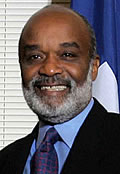Root Cause of Problems in Haiti/ Economic policy5
< Previous | Home | Next >
Haiti has undergone two structural adjustment programmes one in 1986 under the Namphy
government, after Duvalier had been forced out of office; the other in 1994, negotiated upon
the return of elected government in October that year. The economic reforms agreed by the
IMF and other international donors were presented on both occasions as a condition upon
which aid would be received.
As a result of the broad structural adjustment measures which have been applied, Haiti has an
extremely open trade and investment regime, with no price controls, a deregulated banking
sector and a floating exchange rate. These reforms were both far-reaching and implemented
extremely quickly, with no lead-in periods to help manage the transition.
Compared to reforms
in other countries, the Haitian experience can properly be described as one of radical
economic liberalisation: as well as being rapid, the economic reforms were also carried out
under extremely difficult political circumstances.
With regard to import liberalisation, the tariff structure has been simplified and rates greatly
reduced.
With the exception of a 57.8 per cent ceiling tariff on petroleum, the highest tariff rate
is 15 per cent. This simplified tariff structure means there are only six available tariff rates:
duty free, three per cent, five per cent, ten per cent, 15 per cent or 57.8 per cent (for
petroleum only).
The simple average of Haitian tariffs is now 2.9 per cent. This is extremely
low for a developing country in India, for example, the average applied tariff rate 2001/02
was 32.3 per cent.
31
A zero tariff applies to 67 per cent of tariff headings in Haiti.
32
In some respects, trade liberalisation is no longer a relevant topic in economic policy
discussions between donors.
The depth of liberalisation means donors see little new progress
to be made on trade policy.
They are currently focusing on:
·
maintaining macroeconomic stability through monetary policies aimed at controlling
inflation and stabilising exchange rates an IMF mission in March 2005 reviewed the
economic stabilisation measures being taken and delivered a positive assessment of
the government's policy for 2004/05
·
continuing the privatisation effort, which has not advanced in line with the
specifications of donors in 2005 this included a full financial audit of public
enterprises
·
taking steps to attract foreign investment to the country.
Since their recent re-engagement in Haiti, all the multilaterals have expressed their approval
towards the broad economic policy pursued by the government.
This is in stark contrast to the
views of Haitians themselves towards their economy.
Haitian civil society is more likely to
highlight persisting high levels of unemployment, food security challenges, the
`decapitalisation' of the rural population,
33
the huge decline in national production and the
generally dire situation of poor people
Lionne, April 24 2008, 6:34 PM
Start a NEW topic or,
Jump to
previous | Next Topic >
< Previous | Home | Next >
< Previous | Home | Next >

 Rene Preval and Fidel Castro
Rene Preval and Fidel Castro  Rene Preval and Stephen Harper, Canada Prime Minister
Rene Preval and Stephen Harper, Canada Prime Minister  Rene Preval and Josette Sheeran
Rene Preval and Josette Sheeran  Rene Preval and Mahmoud Ahmadinejad
Rene Preval and Mahmoud Ahmadinejad  PHOTO: Haiti President Rene Preval and Bill Clinton in New York
PHOTO: Haiti President Rene Preval and Bill Clinton in New York  Rene Preval in Canada
Rene Preval in Canada  President Rene Preval and Hillary Clinton
President Rene Preval and Hillary Clinton  Rene Preval and Hugo Chavez
Rene Preval and Hugo Chavez  President Rene Preval
President Rene Preval  Rene Preval and Condoleezza Rice
Rene Preval and Condoleezza Rice  President Fidel Castro Hosts Haiti President-elect Rene Preval
President Fidel Castro Hosts Haiti President-elect Rene Preval  Rene Preval Haiti Djakout Mizik Pouvwa
Rene Preval Haiti Djakout Mizik Pouvwa  Caribbean News From Caribworldnews
Caribbean News From Caribworldnews  Bringthepai Preval Pawol Tafia
Bringthepai Preval Pawol Tafia  Discour President Rene Preval Aux Gonaives 1er Janvier 2009
Discour President Rene Preval Aux Gonaives 1er Janvier 2009 

